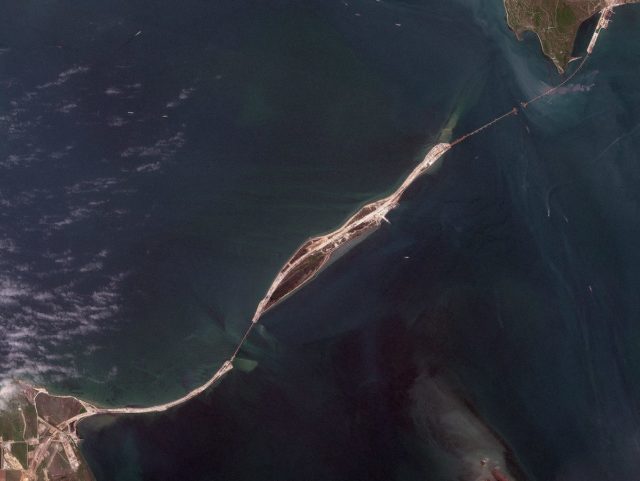
Coveting Thy Neighbor: Russia’s Kerch Bridge Enabling Seizure of Ukrainian Oil and Gas
By:

In the heat of the spring and summer of 2014, a full-scale Russian invasion to create a land bridge to recently annexed Crimea appeared overwhelmingly likely. Such a move by Russia never materialized, though fears of its imminent possibility continued to crop up as violence and tensions along the Donbas front line flared up periodically over the past several years (see EDM, March 30). Yet, throughout this time, the Kremlin continued to seek to cement its hold on the Crimean peninsula. The long-dreamed-of Russian bridge to Crimea was seen as the solution, and planning began in March 2014 (TASS, April 21, 2016).
The combined road-and-rail bridge that will link Russia proper with Crimea (whose only physical land connection is with Ukraine) is currently under construction. The bridge crosses the Kerch Strait, which is a small international waterway that connects the Black Sea to the Sea of Azov, a strategic and economically important body of water for Ukraine (see EDM, July 13, September 6). The ports of Berdyansk and Mariupol lie in the Sea of Azov; in 2013, they handled 2.16 billion and 15.5 billion tons of cargo, respectively (Ccb.at.ua, March 19, 2014). Based on previous treaty agreements between Ukraine and Russia, a mutual arrangement must be reached before any construction in the Kerch Strait is allowed to begin (Fao.org, April 22, 2004). Indeed, the Ukrainian government has not agreed to the ongoing construction of the Kerch Strait Bridge by Russia. This flagrant violation of international law by Moscow, on top of the violation of international law from annexing Crimea, further isolates Russia and gives the West additional reason to sanction the country. Furthermore this $3.5 billion mega project is beset with immense technical and financial challenges that make constructing the bridge even more daunting (see EDM, March 25, 2016). Why then is the Kremlin so determined to see it through?
The answer perhaps lies in the Kremlin’s desire to cement its hold on the natural resources of both the Azov Sea as well as the northern Black Sea more broadly. The northern Black Sea is home to a vast amount of untapped oil and gas resources that Russia gained after its annexation of Crimea; and it has sought to secure its hold over these resources (see EDM, April 14, 2014 and February 17, 2016; The New York Times, May 17, 2014). Meanwhile, the resources found in the small area of the Ukrainian portion of the Sea of Azov amount to 20 billion cubic meters of natural gas, by the estimates of the Crimean oil and gas company Chernomorneftegaz. This is roughly worth $3.4 billion at European Union market price, without factoring in extraction costs (Rpi-research.com, 2012). In context, this would represent 10 percent of Russian state-owned Gazprom’s 2016 exports to Europe by volume (Gazpromexport.ru, accessed November 5). The Kremlin has shown how far it is willing to go to control Ukrainian resources in the Black Sea by illegally seizing them and then using military force to protect its claim (Dpsu.gov.ua, September 7, 2016). In a recent exercise, Russian units demonstrated that if a Ukrainian naval vessel attempted to reassert control over stolen assets, it would be met with a severe military response (UNIAN, October 20).
Given the disrepair of the Ukrainian navy, the construction of the Kerch Strait Bridge could represent the final step in turning the Azov Sea into a Russian lake (RIA Ukraine, March 27, 2014). Besides already adding additional military forces to the theater—essentially creating “Fortress Crimea” (see EDM, December 9, 2014; November 14, 2017)—the Kremlin has talked about allowing the Russian Federal Security Service (FSB) to take jurisdiction over the bridge in order to prevent “terrorist actions,” and has overseen the construction of an Azov Fleet by the separatist, Moscow-backed government in Donetsk, giving Russia the ability to employ paramilitary as well as conventional military capabilities to respond to Ukrainian movements in this body of water (Komsomolskaya Pravda, September 9, 2016; Gordon, March 5, 2016). Furthermore, the very proportions of the bridge are such that they will severely limit the ability of Ukrainian vessels to navigate through the Kerch Strait into and out of the Azov Sea. And in fact, Russia has already closed the Strait entirely for short periods to complete construction (see EDM, September 6), and may try to do so again in the future based on any number of possible justifications.
In demonstrating that Russia is not afraid to flout international law in and around Crimea, it is likely that the construction of the Kerch Strait Bridge will enable it to do the same regarding the currently largely untapped resources in the Azov Sea (Usgs.gov, June 2011). Russia’s de facto control of the Azov Sea will only embolden it to seize existing oil and gas infrastructure and build new facilities to extract resources that are legally within Ukrainian maritime territory.
This all fits with Russia’s efforts to further cripple Ukraine’s access to the sea in order pursue a dual-track strategy of projecting Russian power along the northern Black Sea as well as to enrich the Kremlin and its allies as they exploit the natural resources in the wider Black Sea basin. These goals operate hand-in-hand and should be viewed as a continuation of Russia’s use of oil and gas not just as an instrument of foreign policy but also as a driver of it. Given this increased threat environment, Ukraine will need to continue to build its shore defense capabilities and adapt its naval strategy to respond appropriately to these threats. In Kyiv, the emphasis is often placed on the army at the expense of the navy, but as Russia more aggressively closes in on Ukrainian shores, the issue of a second front or amphibious landing near Mariupol necessitates that the government create a capable amphibious coastal defense force. Only time will tell if Ukraine will shift its strategy in time.



